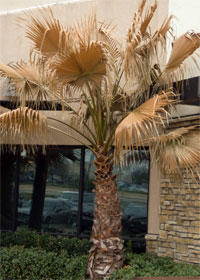Freeze Damage, and What to Do Now

Hopefully you got our special weather alert several weeks ago warning you of imminent extreme and prolonged cold. Hopefully you took the necessary precautions. Even if you did, and certainly if you didn’t, your plants could have been hurt. But, what do you do now? Let’s address the proper steps.
Step 1: What is your Plant Hardiness Zone? You need to know that every time you go to the nursery. Click to the USDA Plant Hardiness Zone Map, South-Midwest US. Find your county, and see which Zone it’s in.
Step 2: Make a list of all your woody plants, both those that were damaged by the cold and those that were not. Make note of each plant’s Hardiness Zone ranking. To use as an example, a plant that’s listed as "Zone 7" should survive average winters in Zone 7 and warmer (Zones 8-9). However, our example of a Zone 7 plant would not survive average winters in colder Zones (6 or 5, as examples).
Step 3: Every tree, shrub, vine or groundcover has been ranked for its Hardiness Zone using that chart. Your nurseryman can show you how to read plant labels to find the Hardiness Zones. If the plants that suffered damage in your gardens are listed for warmer Hardiness Zones, the damage is likely to recur in future winters, too. Those are plants that probably should be replaced as you redo your plantings this spring.
Step 4: Even plants that should make it through a normal winter in your area may have been damaged by the cold this year. If the damaged plant is listed as hardy to your Zone, it probably will come back as growth resumes this spring.
Step 5: It’s still too early to determine the extent of damage to most woody plants. It may be that only the leaves have been killed, in which case it’s best to sit tight and give the plants a chance to regrow with new foliage this spring. Do not prune those plants yet. However, if stems are beginning to shrivel and turn brittle, those tissues can certainly be trimmed off. Cut back until you reach live, vigorous stem tissue.
Step 6: Jump ahead by 4-6 weeks. By early or mid-March, you’ll be able to tell the full extent of dieback, if any. Some plants may have been killed entirely to the ground, but most of those will at least send up new shoots starting in late March or April. Once you can tell how serious the damage is with certainty, trim and reshape the plants. But, be patient. Don’t rush to trim.
Step 7: Groundcovers are a different story. Asian jasmine was browned by the cold over much of the state. If that happened to yours, it will come back, but you’ll probably want to get the browned stubble out of the way. Use a line trimmer or your mower (highest possible setting) to scalp off the dead growth. If will look pretty bare initially, but it will be tidy. Then, in March, new growth will emerge, and the bed will really look nice. Finally, if you need to trim mondograss or liriope, do so before mid-February to be sure you don’t trim into new, green candles of growth. Once new growth commences, it’s a lot more difficult to trim these clumping groundcovers.

